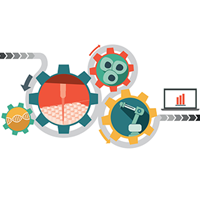Advances in automated analytical tools for cell therapy manufacturing
Cell Gene Therapy Insights 2017; 3(8), 651-654.
10.18609/cgti.2017.064
What do you see as the major bottlenecks for the commercialization of cell-based products?
The major bottlenecks that need to be addressed for the successful commercialization of cell therapies are the scale-up of the manufacturing processes and analytical methods, and for autologous T-cell products, the management of apheresis-related activities.
Unlike an allogeneic product where a single production lot can supply thousands of people, autologous therapies require that a new lot of cells be made for every patient. To address this challenge, manufacturing processes will need to be streamlined to make them more reliable, efficient and cost effective. Emphasis also needs to be placed on the development of meaningful analytical methods that are based on an understanding of the product’s critical quality attributes. With time and experience, a focus on these areas of development will lead to more robust and practical manufacturing processes.
The manufacturing of autologous cell products is also highly reliant on resources that are based in academic research hospitals. Manufacturers rely on the hospital for appropriate staffing and training of clinical apheresis centres. The processes that are run at these institutions are intrinsically variable, and involve a level of oversight that is currently outside the GMP umbrella. As more and more cell therapies are advanced, companies will need to start stepping outside of the traditional academic centres to reach a larger population. Currently, the demand forecast for autologous CAR-T cell products is a bit incongruous with the level of staffing and infrastructure needed to support full-scale commercial manufacturing.
Novartis and Kite will soon release their first commercial products into the market. The field will be learning from them. Estimates on manufacturing reliability, cost and all of the associated factors for commercializing a cell therapy will be tested when these products are in the market. I think we’ll find that a lot of iteration and refinement is still going to be needed.
How important are analytical methods and assays in cell therapy processing? Are they very different for cell therapy products compared to traditional biologics?
Analytical methods are necessary tools in cell therapy manufacturing, for control of the manufacturing process, raw materials, intermediates and the product. They are also important for process development, to characterize processes and enable process changes.
Analytical methods used for characterizing cell therapies are quite different from those of pharmaceutical or biologics drugs. Cells are inherently complex entities. The analytical methods used to characterize them are similarly complex. Sensitive and meaningful analytical methods are necessary for successful process development. The challenge lies in connecting the method to a meaningful product attribute and then showing that it makes a clinical difference. At this point, the manufacturing processes used for making cell therapies are quite crude in comparison to a protein therapy, for example. An investment in new analytical technologies and identification of the important critical quality attributes of a cell are necessary steps towards improving cell therapy manufacturing processes.
What are the key challenges in developing assays for product and process characterization?
The autologous nature of many cell therapies is a large challenge when it comes to developing analytical methods. A second challenge is the complexity of assays. In a research lab, biologists have the flexibility to use data-intensive techniques. These technologies, however, are still in the process of being adapted from to a GMP setting. The translation of complex analytical methods from a research lab where a skilled operator is needed to execute assays and interpret data, to an assay that is simplified and more appropriate for a quality control staff, is a real challenge. The biggest example of this is probably flow cytometry. For years, flow cytometry was a tool that was exclusively used in research labs. The technology has grown incredibly and the instruments have improved dramatically over the past 10 years.
At some point, the widespread use of complex data-intensive technologies converges with a need for simplified but meaningful analytics.
To accommodate the analytical challenges, it is critical to invest in more rapid and high throughput analytical methods as well as tools for data analysis. This involves creating a broad set of analytical tools, identifying the most meaningful methods and increasing assay quality and efficiency.
Can you elaborate on the advantages of using automated analytical tools in cell therapy manufacturing?
Introducing automation in analytics is an option for improving throughput, as it offers the possibility of increasing assay speed and quality while reducing errors, turnaround time and cost. The need for automation is particularly apparent when we think about autologous cell therapies. In an analytical testing lab, automation is used to batch samples, enabling many product lots to be tested and analyzed at once. In general, automating analytical methods is not an insurmountable challenge. Automating assays for an autologous cell product, where each sample represents a different patient’s product, introduces some unique challenges.
There’s discussion in the industry about a modular versus a fully automated approach. What are your thoughts?
A fully automated approach is alluring because it significantly reduces the demand on labor and can facilitate the transfer of a method to different QC labs. However, given the stage of development that cell therapies are in right now, I think a modular approach is more practical. We can expect that any current cell therapy is going to have a relatively short shelf life with ‘the next best thing’ close on its heels. This creates a need for companies to develop multiple products and think carefully about life cycle management. For such a rapidly changing environment, a fully automated approach is a time consuming and costly investment. Instead, I think that it makes more sense to only automate the portions of an assay or process that are significant bottlenecks. This ‘modular’ approach is also more accessible, easier to implement and can be applied as a platform across different product types.
Regardless of the approach, an assay should be simplified and the sources of error must be well understood before attempting to automate. Otherwise, it may prove difficult to bridge from the standard manual method.
What are the potential implications of using automated analytical tools in terms of regulation?
Complying with the FDA 21CFR Part 11 (Electronic Records; Electronic Signatures) is a significant challenge for using automated analytical tools. Many vendors of cell therapy instruments now offer Part 11 compliant software. However, based on our experience, these software developers are just checking a box and not offering a large compliance benefit. The real challenge is making sure that the sample that goes into the assay is appropriately linked to its corresponding test result. Maintaining sample chain of custody is particularly important for autologous therapies and it’s going to require not just new software but new systems to ensure the patients are getting their own cells and not someone else’s.
What are some of the processes Celgene is taking to automate cell therapy manufacturing?
We’re definitely keeping a very close eye on the technology companies that are investing in automation. The field still has a way to go before we see impactful automation. Despite the positive press, fully automated systems currently require significant customization. In my opinion, the automation systems are still at a proof-of-concept stage.
That being said, there are other ways of achieving a positive benefit aside from full automation. Simplifying processes by making them less operator dependent, for example, is another way of achieving the same goal.
Where do you see the next opportunities for advancing the automation of cell therapies?
The field is advancing steadily and will continue to develop as more commercial products come into the market. This positive momentum should help entice more technology vendors that are looking to collaborate with companies on automation solutions.
The cell manufacturing processes today are still lengthy and crude. I expect we’ll see the field look increasingly for ways to change the paradigm of how we manufacture cells. This will introduce shorter manufacturing processes and more refined cell products. Success in this endeavor is going to require an improved understanding of the connections between product attributes and clinical response. An off-the-shelf ‘universal’ CAR T product is another paradigm-shifting approach that should gain attraction. Companies that invest in the science and are willing to tackle the significant regulatory challenges associated with these types of products will be successful.
Affiliation
Christopher Wiwi
Director of Cell Therapy Analytical R&D, Celgene Corporation
This work is licensed under a Creative Commons Attribution- NonCommercial – NoDerivatives 4.0 International License.


